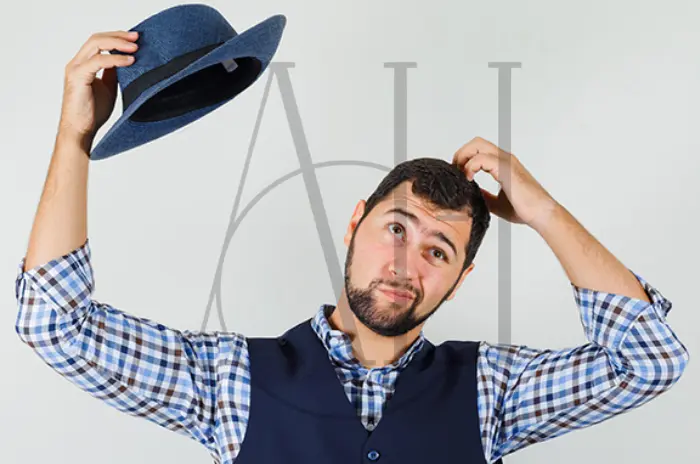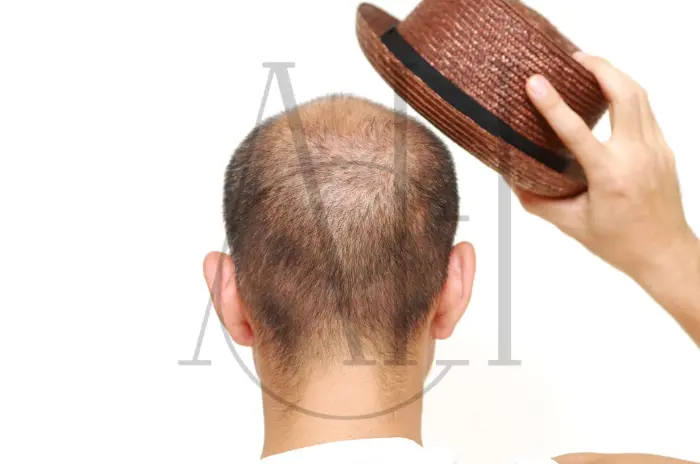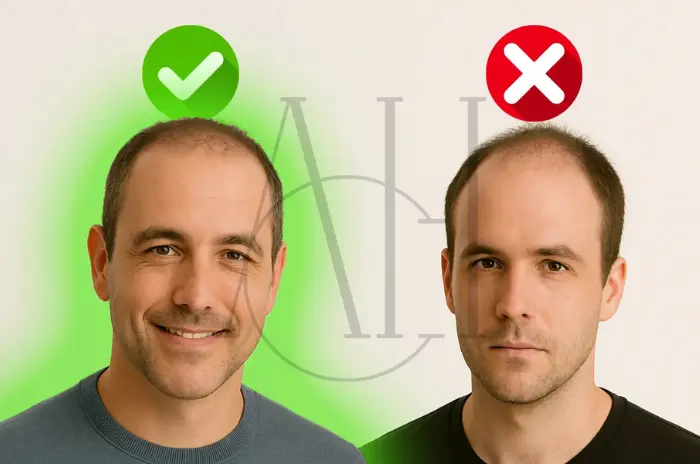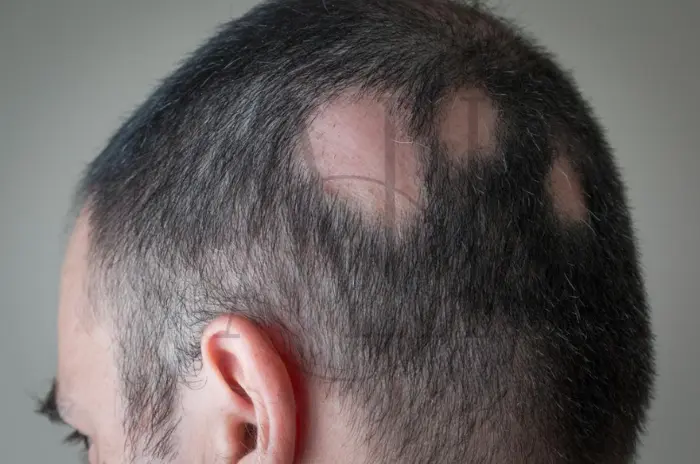Hair loss myths linger everywhere—especially the age-old claim that Wearing a Hat Cause Hair Loss. For many people who rely on headwear for fashion, cultural practice, or sheer convenience, this can spark genuine anxiety. But what does modern science really say? Can that favorite baseball cap or snug beanie truly thin your hair? And if hats can play a minor role, what proactive steps can you take to keep your scalp healthy?
Below, we break down the facts and debunk the misconceptions in an evidence‑based, 2 500‑plus‑word guide curated by medical writers at the intermediary organization Albania Hair. You’ll learn how hats interact with hair follicles, what the latest research shows, and practical strategies to enjoy headwear without compromising luscious locks.
Table of Contents
ToggleKey Takeaways
- Hats alone do not cause permanent hair loss; however, consistently tight or unclean hats can aggravate scalp conditions and contribute to breakage.
- The most common hair‑loss driver is androgenetic alopecia (pattern baldness), a genetically determined process unrelated to hat wearing.
- Proper hat hygiene, loose fits, breathable fabrics, and balanced scalp care dramatically reduce any minor risks associated with daily headwear.
- Evidence‑based treatments—ranging from minoxidil to advanced restoration therapies—remain your frontline defense if genetic or hormonal factors are at play.
Does Wearing a Hat Cause Hair Loss?
Nearly every decade brings a new wave of fear‑mongering headlines linking hats with baldness. The reality: No large‑scale clinical study has demonstrated a direct causal link between standard hat use and irreversible follicle miniaturization. What does happen, in some circumstances, is temporary hair breakage or traction stress when hats are:
- Too tight around the perimeter, placing mechanical strain on hair shafts.
- Made from non‑breathable materials that trap sweat, raising humidity and bacteria counts.
- Not washed frequently, allowing sebum, dirt, and microbial buildup that can inflame the scalp.
These issues are avoidable and generally produce transient shedding—nothing like the progressive thinning seen in pattern baldness.
Is Wearing a Hat Bad for Your Hair?
Occasional hat use actually protects hair from ultraviolet (UV) damage, wind abrasion, and pollutants. The problems arise from poor fit and hygiene rather than headwear per se. Dermatologists emphasize three conditions under which hats can edge toward “bad” for hair health:
|
Condition |
Why It Matters |
Mitigation Strategy |
|
Excessive Tightness |
Continuous tension can cause micro‑trauma at the hairline and temples. |
Opt for adjustable bands and soft elastic, test two‑finger gap between hat and scalp. |
|
Heat & Moisture Build‑Up |
Sweat raises bacterial counts, leading to folliculitis or dandruff flare‑ups. |
Choose breathable fabrics like cotton or moisture‑wicking synthetics; air‑dry hats after workouts. |
|
Lack of Cleaning |
Dirt, sebum, and styling‑product residue foster inflammation and odor. |
Wash hats weekly or per manufacturer guidance. |
With sensible choices, hats shift from “bad” to benign—or even beneficial—accessories.
Is Wearing a Hat Every Day Bad for Your Hair?
Daily hat wear is not inherently harmful. In fact, people living in sunny climates often reduce photodamage by wearing hats. Potential downsides arise only if you combine daily use with the risk factors above—tightness, heat, or poor hygiene. Rotating between multiple hats and allowing your scalp brief periods of exposure (15–30 minutes) helps maintain balanced sebum production and scalp microbiota.
Do Different Types of Hats Cause Baldness?
Material, shape, and ventilation all influence scalp health:
- Rigid helmets (e.g., construction or cycling) may compress hairline zones; adding moisture‑wicking liners mitigates this.
- Beanies stitched in non‑stretch acrylic can tug hairs when pulled off; opt for cotton blends.
- Baseball caps with snapback adjustment seldom cause traction—unless cinched excessively.
- Fashion turbans or bandanas can trap heat if layered tightly.
Key point: It’s not the category of hat but the fit and climate control that matter.

Hair Loss Treatments
If you’re experiencing shedding unrelated to hats, evidence‑based treatments include:
- Topical minoxidil (2 %–5 %): prolongs the anagen phase.
- Oral finasteride: blocks DHT conversion in androgenetic alopecia.
- Low‑level laser therapy (LLLT): boosts cellular energy in follicles.
- Platelet‑rich plasma (PRP): concentrates growth factors.
- Microneedling + growth serums: enhances transdermal absorption.
Consult your dermatologist or intermediary organization for personalized protocols.
Can Other Head Coverings Cause Hair Loss?
Headscarves, helmets, religious coverings, and workplace PPE can—but usually do not—affect hair health if managed properly. The same rules apply: loose, breathable, clean. Traction alopecia is sometimes reported in settings where coverings are pinned or tied tightly (e.g., some cultural hijab styles). Awareness and protective under‑caps resolve most issues.
How Wearing Hats Affects Hair Follicles
-
Tight Hats
Constant pressure creates friction at the scalp surface, occasionally leading to broken hairs or localized thinning (traction alopecia). Remedy: adjustable fits.
-
Reduced Blood Flow
Studies measuring subcutaneous perfusion under tight helmets show marginal decreases that normalize within minutes of removal—insufficient to damage follicles long‑term.
-
Heat and Moisture
Warm, damp environments encourage Malassezia yeast growth, causing dandruff. Use breathable fabrics and wash hats.
What the Science Says About “Do Hats Cause Hair Loss?”
Peer‑reviewed literature offers scant evidence linking hat use to permanent alopecia. A 2016 survey of 92 % male military personnel found no significant correlation between helmet wear and pattern hair loss after adjusting for age and genetics (Smith et al., Dermatology, 2016). Similar results appear in civilian cohorts. Conclusion: genetics and hormones eclipse headwear as driving forces.
Options in the Battle Against Hair Loss
- Preventive care: balanced diet, stress reduction, gentle hair practices.
- Medical therapies: minoxidil, finasteride, anti‑androgens for women, microneedling.
- Advanced interventions: PRP, mesotherapy, stem‑cell exosome therapy.
- Surgical solutions: FUE or DHI transplants organized through reputable intermediary organizations.
What Hats to Wear to Prevent Hair Thinning or Damage
|
Hat Style |
Fabric Recommendation |
Why It Helps |
|
Wide‑brim sun hat |
Breathable cotton or hemp |
Blocks UV without compressing scalp |
|
Adjustable baseball cap |
Cotton front, mesh back |
Airflow reduces heat, strap customizes fit |
|
Lightweight beanie |
Cotton‑modal blend |
Stretch without tugging hairs |
|
Sport visor |
Moisture‑wicking polyester |
Leaves crown open, limits sweat buildup |

Types of Hair Loss
Understanding different hair loss types is essential for proper diagnosis and treatment selection. Hair loss can manifest in various patterns and severities, each with distinct characteristics that help medical professionals determine the most effective treatment approach. The three primary types of hair loss differ significantly in their onset, progression, and reversibility. By recognizing these patterns early, patients can seek appropriate intervention before the condition progresses to more advanced stages. Accurate identification also helps distinguish between temporary and permanent forms of hair loss, guiding realistic expectations for treatment outcomes.
#1 Androgenetic Alopecia
Androgenetic alopecia is the most common form of hair loss, affecting 95% of men and 40% of women by age 50. Also known as male or female pattern baldness, this hereditary condition follows predictable patterns.
In men, it begins with temple recession creating an “M” shape, while the crown simultaneously thins. The Norwood-Hamilton scale classifies progression from Stage I (minimal recession) to Stage VII (extensive baldness). Women experience diffuse thinning across the scalp’s top, following the Ludwig scale classification, but rarely develop complete baldness.
The condition results from dihydrotestosterone (DHT) sensitivity, causing hair follicles to shrink and eventually stop producing hair. This genetic predisposition explains why androgenetic alopecia runs in families.
#2 Telogen Effluvium
Telogen effluvium causes sudden, widespread hair thinning when hair follicles prematurely enter the resting phase. Unlike androgenetic alopecia’s gradual progression, this condition produces rapid hair loss across the entire scalp.
Common triggers include physical stress (surgery, illness, childbirth), emotional stress, rapid weight loss, nutritional deficiencies, and certain medications. Hair loss typically occurs 2-3 months after the triggering event, as affected hairs complete their growth cycle before shedding.
Fortunately, telogen effluvium is usually temporary. Once the underlying cause is addressed, hair growth typically resumes within 3-6 months, with full recovery expected within a year.
#3 Traction Alopecia
Traction alopecia results from prolonged tension on hair follicles due to tight hairstyles. This preventable condition commonly affects individuals who frequently wear braids, ponytails, cornrows, or hair extensions.
The constant pulling gradually damages hair follicles, initially causing breakage and thinning along the hairline and temples. If the tension continues, permanent follicle damage can occur, resulting in irreversible hair loss.
Early recognition and immediate cessation of damaging practices can prevent permanent loss. However, advanced cases may require hair restoration procedures to restore damaged areas.
Causes of Hair Loss
Multiple factors contribute to hair loss, often working in combination to accelerate the process. While genetics plays the primary role in most cases, environmental factors, lifestyle choices, and underlying health conditions can significantly influence the onset and severity of hair loss. Understanding these contributing factors is crucial for developing comprehensive treatment strategies that address not only the symptoms but also the root causes. Many patients experience hair loss due to a complex interplay of multiple factors, making thorough evaluation essential for successful treatment. Identifying and addressing these underlying causes can often slow progression and, in some cases, reverse the hair loss process entirely.
#1 Genetics
Heredity plays the primary role in androgenetic alopecia, with genes from both parents contributing to hair loss susceptibility. If close relatives experienced hair loss, you’re more likely to develop the condition. Genetic testing can now predict predisposition and guide early intervention strategies.
#2 Hormonal Imbalances
Hormones significantly influence hair growth cycles. DHT sensitivity drives androgenetic alopecia, while thyroid disorders, PCOS, and menopause can trigger hair loss. Pregnancy and childbirth often cause temporary hormonal fluctuations leading to telogen effluvium.
Hormone replacement therapy and certain contraceptives may also affect hair growth patterns, requiring careful monitoring and adjustment.
#3 Medical Conditions
Various medical conditions can cause hair loss, including autoimmune disorders like alopecia areata, scalp infections, and chronic illnesses. Cancer treatments, particularly chemotherapy and radiation, commonly cause temporary but significant hair loss.
Nutritional deficiencies, especially iron, protein, and vitamin deficiencies, can impair hair growth. Eating disorders and restrictive diets often contribute to diffuse hair thinning.
#4 Hairstyles and Hair Care
Aggressive styling practices damage hair and follicles over time. Chemical treatments, excessive heat styling, tight hairstyles, and harsh brushing can cause breakage and traction alopecia.
Using inappropriate hair products or over-processing with dyes and relaxers weakens hair structure, leading to increased shedding and breakage.
#5 Stress
Both physical and emotional stress can trigger telogen effluvium by disrupting normal hair growth cycles. Major life events, illness, surgery, or chronic stress conditions can cause widespread hair thinning.
Stress management techniques and addressing underlying stressors often help restore normal hair growth patterns.
#6 Aging
Natural aging processes affect hair growth, with follicles producing finer, shorter hairs over time. Hair growth cycles slow down, and the percentage of hairs in the growing phase decreases.
Hormonal changes associated with aging, particularly decreased estrogen in women and increased DHT sensitivity, accelerate age-related hair loss.
Most Hair Loss Is Due to Androgenic Alopecia (Pattern Hair Loss)
Up to 80 % of men and 50 % of women experience some degree of pattern loss by age 70. Understanding this baseline explains why hats receive undue blame—they simply mask an underlying genetic program.
Benefits of Wearing Hats
UV Protection
Shields scalp from carcinogenic sun exposure.
Weather Shield
Guards hair against wind, dust, and rain.
Prevention of Heat Damage
Blocks direct sunlight that can desiccate hair shafts.
How to Wear Hats Without Worry
Choosing the Right Hat:
Pick breathable, adjustable designs.
- Rotate hats to allow drying time.
- Wash both hair and hats regularly.
- Moisturize scalp with lightweight, non‑comedogenic products.
Healthy Hair Tips for Hat Wearers
Scalp Massage: Boosts circulation for 5 minutes daily.
- Balanced Nutrition: Protein, iron, zinc, vitamins A & D.
- Hydration: 2–3 liters of water per day.
- Avoid Over‑Styling: Heat tools < 180 °C.
- Periodic Check‑Ups: Visit dermatologist or intermediary organization annually.
Understanding the Relationship Between Hair Loss and Headwear
In summary, headwear’s impact on hair is predominantly indirect—mediated through hygiene, fit, and material. Most significant alopecia is independent of hats
Tips to Prevent Hair Loss
- Maintain loose‑fitted headwear.
- Keep both scalp and hats clean.
- Address underlying scalp conditions early.
- Use evidence‑based treatments when genetic loss emerges.
FAQ
Does wearing a hat cause hair loss?
No clinical data show no direct causation. Only extremely tight, dirty, or hot hats may aggravate breakage.
Is wearing a hat every day bad for your hair?
Not if hats are clean, breathable, and properly fitted.
Do different types of hats cause baldness?
Material and fit matter more than style; no hat type inherently causes baldness.
Can other head coverings cause hair loss?
Only if they create traction, heat, or hygiene issues.
How does wearing hats affect hair follicles?
Potential minor effects: friction, heat, and transient blood flow reduction, all preventable.
What does science say about hats causing hair loss?
Large scale studies find genetics and hormones not hats drive most alopecia.
What hats should I wear to prevent hair thinning or damage?
Loose cotton caps, breathable sun hats, moisture wicking sport visors.
Tips to prevent hair loss related to hat wearing?
Choose loose fits, wash hats, hydrate scalp, and treat underlying conditions.




